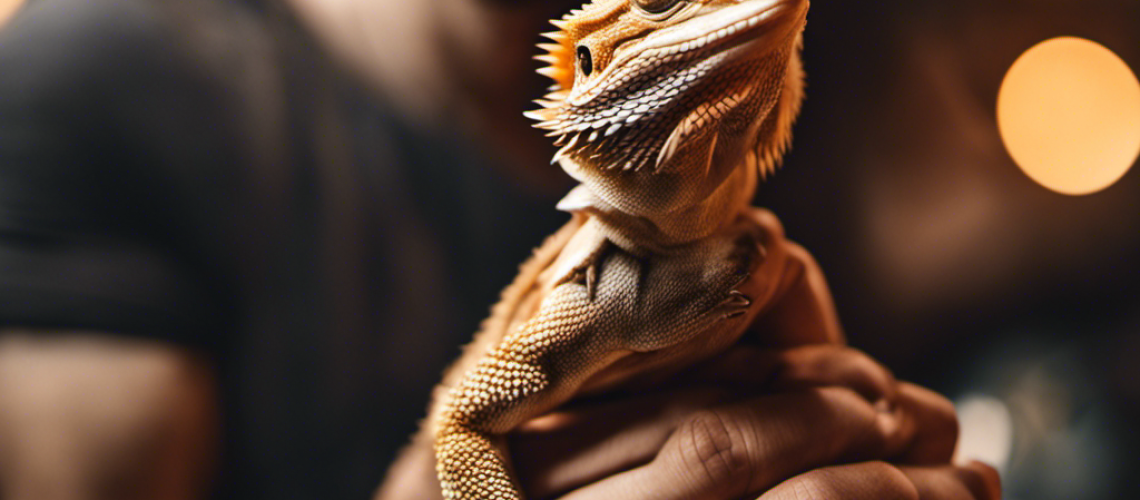Bearded dragons are a popular reptile pet. Many owners wonder if they enjoy being held. There are some risks associated with holding bearded dragons, as well as techniques that can help make it a better experience for both owner and pet.
This article will explore the benefits of holding your bearded dragon. It will also discuss signs of happiness to look out for and provide tips to ensure a positive experience.
Key Takeaways
- Holding bearded dragons can have positive effects on their physical, emotional, and psychological health.
- Proper handling techniques, such as providing support and avoiding sudden movements, can help the dragon feel comfortable and safe while being held.
- Signs of happiness in bearded dragons include increased activity and seeking out interactions, investigating surroundings or playing with toys, relaxed body language, basking in sunlight or exploring their environment, and having a healthy appetite and regular shedding.
- It is important to balance bonding time with natural behaviors like basking and exploring, and to monitor the bearded dragon’s behavior and well-being during holding sessions.
Benefits of Being Held
Being held appears to provide physical and mental benefits for bearded dragons. Socializing and bonding with their owners can help the animal feel loved, secure, and safe. Stimulation from touch may also produce endorphins which in turn promote overall well-being.
In addition, time spent being handled can be a great opportunity for exercise as the dragon’s limbs are stretched and muscles strengthened. Thus, allowing your bearded dragon to be held is likely to have numerous positive effects on its physical, emotional, and psychological health.
Holding Techniques
Holding bearded dragons may result in a positive experience, depending on the technique employed. Bathing techniques such as warm water baths and handling safety should be taken into consideration when attempting to hold a bearded dragon.
It is important to ensure that the dragon is comfortable and relaxed while being held, by providing support with both hands and avoiding sudden movements. Giving gentle strokes along the back helps create a safe atmosphere for the reptile, allowing it to remain calm and trusting of its owner.
Additionally, voice commands can be used to soothe them during their holding experience.
Signs of Happiness
Reptiles may exhibit certain behaviors that indicate they are content when being handled. Signs of happiness in bearded dragons include:
- Socializing, such as increased activity and seeking out interactions with humans
- Environmental enrichment, such as investigating their surroundings or playing with toys
- Relaxed body language, like a lowered chin or an open mouth with relaxed facial muscles
Risks of Holding
Due to the delicate nature of reptiles, holding them carries certain risks. Stress management is a key factor in ensuring the safety and well-being of a bearded dragon when held. If they are feeling threatened or overwhelmed, they can become stressed and display signs of distress such as hissing, biting, or scratching.
In addition to stress management, it is important to ensure that the amount of time spent being held does not interfere with other aspects of their daily lives such as eating and exercising. Bonding time should be balanced with activities that promote natural behaviors like basking in sunlight and exploring their environment.
Tips for a Positive Experience
In order to create a positive experience for both the reptile and its handler, certain precautions should be taken.
First, interactive play is important; this not only strengthens the bond between owner and pet, but also allows for a greater level of understanding.
Additionally, environmental enrichment can provide stimulation and encourage exploration.
Frequently Asked Questions
How Often Should I Hold My Bearded Dragon?
Bearded dragons should not be held often. Instead, provide them with environmental enrichment such as regular bathing time to help stimulate their senses and keep them active. This will ensure they remain content and happy while avoiding potential stress from frequent handling.
What Other Activities Can I Do With My Bearded Dragon?
Bearded dragons enjoy environmental enrichment activities such as exploring, being handled safely and playing with interactive toys. These activities provide stimulation that is essential to their physical and mental wellbeing. Handling with safety should always be prioritized for the comfort of the dragon.
Are Bearded Dragons Good Pets for Young Children?
Bearded dragons make suitable pets for young children, given that their handling is done with care and proper supervision. Bonding time with a bearded dragon should include fundamental handling tips such as providing gentle, short holding periods. Doing so can create a positive relationship between the pet and child.
How Long Do Bearded Dragons Live?
Bearded dragons typically live between five to eight years, though life expectancy is greatly affected by their breeding habits and any health concerns. Proper care is essential for a long and healthy life for these lizards.
What Do Bearded Dragons Like to Eat?
Bearded dragons have particular dietary needs that must be met to maintain health and wellbeing. They primarily feed on small insects, such as crickets, mealworms, wax worms, and roaches. Supplementing their diet with vegetables will help ensure they receive a balanced nutrition. A proper enclosure setup should include a large dish for feeding and another for providing water.
Conclusion
Being held can be a positive experience for bearded dragons if done correctly. When handled with care, it can help to build trust and encourage bonding between the dragon and its owner.
It is important to note that some dragons may not enjoy being held and should never be forced into an activity they do not enjoy. Signs of happiness include purring, tail flicking, and increased interaction with their environment.
With patience, understanding, and proper techniques, holding a bearded dragon can be a rewarding experience for both parties involved.






